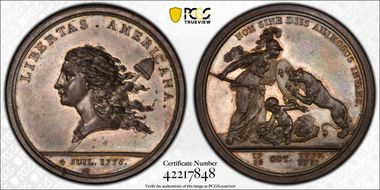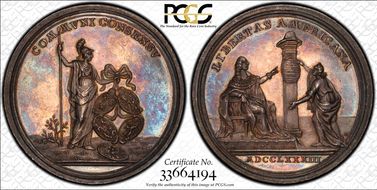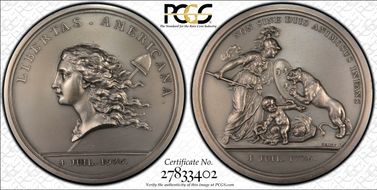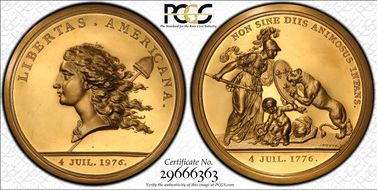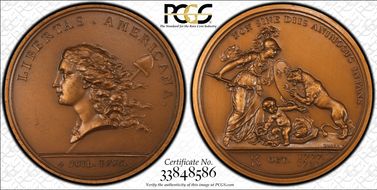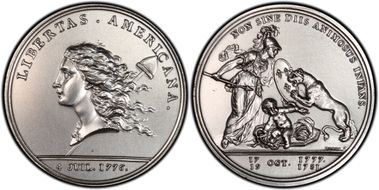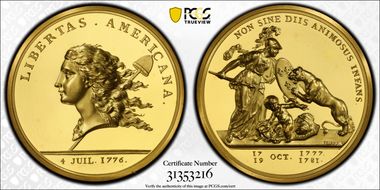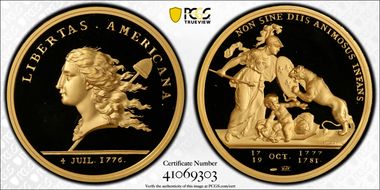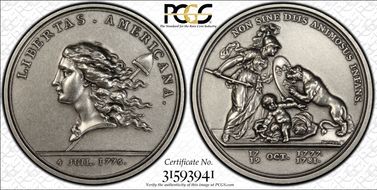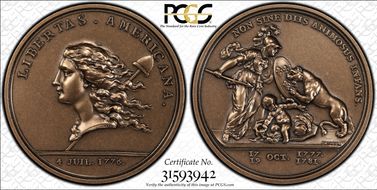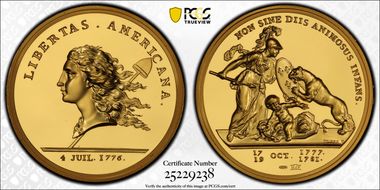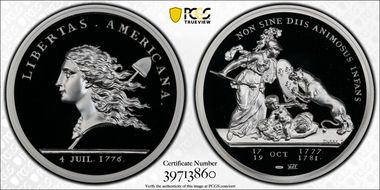Cardinal 的钱币相册
This fabulous specimen of the Original Silver Libertas Americana Medal ranks at the 2nd place in the known population. Tracing back to the legendary coin dealer Virgil Michael Brand, this medal passed on to Burdette Garner Johnson after Virgil's death. Sadly, Burdette Johnson was unmarried. During the Great Depression, Johnson took in a young girl named Mary Cruzan who had been abandoned by her parents. He raised and educated her as his own daughter, and Cruzan later inherited the entirety of Johnson's U.S. colonial coin stock. Cruzan's inherited stock was sold at record auction for $1.1 million USD after Cruzan's own death in 1996. Thereafter, Alan Weinberg owned this medal until it passed to The Cardinal Collection Educational Foundation in January 2013. Truly pristine, this specimen also ranks as the heaviest specimen of the known population, coming from a later die state, with die breaks more notable.
This fabulous specimen of the Original Silver Libertas Americana Medal ranks at the 2nd place in the known population. Tracing back to the legendary coin dealer Virgil Michael Brand, this medal passed on to Burdette Garner Johnson after Virgil's death. Sadly, Burdette Johnson was unmarried. During the Great Depression, Johnson took in a young girl named Mary Cruzan who had been abandoned by her parents. He raised and educated her as his own daughter, and Cruzan later inherited the entirety of Johnson's U.S. colonial coin stock. Cruzan's inherited stock was sold at record auction for $1.1 million USD after Cruzan's own death in 1996. Thereafter, Alan Weinberg owned this medal until it passed to The Cardinal Collection Educational Foundation in January 2013. Truly pristine, this specimen also ranks as the heaviest specimen of the known population, coming from a later die state, with die breaks more notable.
Though bearing the evidence of its share of handling over the centuries, this particular specimen of the Libertas Americana medal is the single earliest example struck in Bronze that this researcher has found. The obverse plainly displays multiple strikings from the dies -- with offsets between strikes -- and yet there is very little evidence of the extensive die damage that is displayed on the vast majority of the Bronze Medals. In addition to the earliest die state specimen of the Libertas Medal (and Red Brown!), the collection includes a fantastically preserved specimen, gem MS65 Bronze example of the Libertas Americana Medal that is the finest seen by this researcher. Its die state places it near the middle of the production period, with considerable die damage now visible in comparison to the early die state silver and bronze medals in the Collection, yet not so advanced as the very latest die state examples.
Though bearing the evidence of its share of handling over the centuries, this particular specimen of the Libertas Americana medal is the single earliest example struck in Bronze that this researcher has found. The obverse plainly displays multiple strikings from the dies -- with offsets between strikes -- and yet there is very little evidence of the extensive die damage that is displayed on the vast majority of the Bronze Medals. In addition to the earliest die state specimen of the Libertas Medal (and Red Brown!), the collection includes a fantastically preserved specimen, gem MS65 Bronze example of the Libertas Americana Medal that is the finest seen by this researcher. Its die state places it near the middle of the production period, with considerable die damage now visible in comparison to the early die state silver and bronze medals in the Collection, yet not so advanced as the very latest die state examples.
Related to the famous Libertas Americana medals, the Peace of Versailles medal bears the obverse legend of "Libertas Americana." Sometimes also called the "Communi Consensu" medal, this issue commemorates the acceptance of the America's newborn liberty by the "common consent" of the nations of the world. Seen here is a superbly toned example of the medal struck in silver.
Related to the famous Libertas Americana medals, the Peace of Versailles medal bears the obverse legend of "Libertas Americana." Sometimes also called the "Communi Consensu" medal, this issue commemorates the acceptance of the America's newborn liberty by the "common consent" of the nations of the world. Seen here is a superbly toned example of the medal struck in silver.
During a visit to the Paris Mint in 1958, John J. Ford re-discovered the previously lost original dies for the Libertas Americana Medal in the Mint's Museum "Musee de Monnaies." As the U.S. Bicentennial grew nearer, he suggested to Stanley Applebaum of First Coinvestors that transfer dies be created for a bicentennial commemorative restriking. First Coinvestors funded the project, in exchange for the exclusive rights of the new dies. The dies were expanded to a diameter of 77mm, and the dates were changed on the obverse and reverse dies. Further markings were added to the edge, to designate the restrikes as "COPY OF DESIGN BY BENJAMIN FRANKLIN - ORIGINAL STRUCK IN 1783". Just 500 examples were struck in silver, as in the specimen seen here. Records report that 3 examples were also struck in gold (likely .920 fineness), but none are known today. Presumably, melted for their high bullion value during 1980.
During a visit to the Paris Mint in 1958, John J. Ford re-discovered the previously lost original dies for the Libertas Americana Medal in the Mint's Museum "Musee de Monnaies." As the U.S. Bicentennial grew nearer, he suggested to Stanley Applebaum of First Coinvestors that transfer dies be created for a bicentennial commemorative restriking. First Coinvestors funded the project, in exchange for the exclusive rights of the new dies. The dies were expanded to a diameter of 77mm, and the dates were changed on the obverse and reverse dies. Further markings were added to the edge, to designate the restrikes as "COPY OF DESIGN BY BENJAMIN FRANKLIN - ORIGINAL STRUCK IN 1783". Just 500 examples were struck in silver, as in the specimen seen here. Records report that 3 examples were also struck in gold (likely .920 fineness), but none are known today. Presumably, melted for their high bullion value during 1980.
Prior to the striking of the planned production run of 500 silver medals for First Coinvestors, the Paris Mint tested the dies by producing 5 trial strikes in bronze, as seen here. Clearly, these were executed in brass or "yellow bronze," in keeping with U.S. Mint trends during the latter 20th Century. A careful comparison of the brass specimen with the silver examples confirms its trial strike status, as it displays a definitively earlier die state than seen on the silver medals.
Prior to the striking of the planned production run of 500 silver medals for First Coinvestors, the Paris Mint tested the dies by producing 5 trial strikes in bronze, as seen here. Clearly, these were executed in brass or "yellow bronze," in keeping with U.S. Mint trends during the latter 20th Century. A careful comparison of the brass specimen with the silver examples confirms its trial strike status, as it displays a definitively earlier die state than seen on the silver medals.
A further extension of First Coinvestors rights to the new 77mm Libertas dies, bronze "Copies" such as this one were struck in 1983 for the Bicentennial. Whereas the 1976 Silver "Copies" celebrated the bicentennial of the signing of the Declaration of Independence, these 1983 Medals were dated "1783 3 SEPT 1983", to commemorate the bicentennial of the signing of the Peace Treaty that ended the Revolutionary War.
A further extension of First Coinvestors rights to the new 77mm Libertas dies, bronze "Copies" such as this one were struck in 1983 for the Bicentennial. Whereas the 1976 Silver "Copies" celebrated the bicentennial of the signing of the Declaration of Independence, these 1983 Medals were dated "1783 3 SEPT 1983", to commemorate the bicentennial of the signing of the Peace Treaty that ended the Revolutionary War.
While the Paris Mint may have given First Coinvestors the exclusive rights to the 77mm dies, it reserved for itself the rights to restrike the Libertas Americana medals in other sizes, and a number of restrikes have appeared since that time. The Silver Restrike seen here was produced in an open issue for visitors to the Mint beginning shortly after the U.S. Bicentennial. These are distinguished by a double cornucopia edge mark and a stamp of ".925" to designate the fineness of the silver. Similarly, Bronze Restrikes were also produced in open issue and bear edge markings to designate their official Paris Mint origin.
While the Paris Mint may have given First Coinvestors the exclusive rights to the 77mm dies, it reserved for itself the rights to restrike the Libertas Americana medals in other sizes, and a number of restrikes have appeared since that time. The Silver Restrike seen here was produced in an open issue for visitors to the Mint beginning shortly after the U.S. Bicentennial. These are distinguished by a double cornucopia edge mark and a stamp of ".925" to designate the fineness of the silver. Similarly, Bronze Restrikes were also produced in open issue and bear edge markings to designate their official Paris Mint origin.
In addition to the open issue silver restrikes, Bronze Restrikes were also produced by the Paris Mint in an open issue following the U.S. Bicentennial. These bear edge markings to designate their official Paris Mint origin.
In addition to the open issue silver restrikes, Bronze Restrikes were also produced by the Paris Mint in an open issue following the U.S. Bicentennial. These bear edge markings to designate their official Paris Mint origin.
The Silver Restrike seen here was issued for the New Millenium in 2000 in a limited edition of 2500 pieces, each 45.86mm in diameter and containing 42.80 grams of .950 silver. For this issue, the Paris Mint used the same dies that had been used to produce the earlier Bronze restrikes sold to Mint visitors.
The Silver Restrike seen here was issued for the New Millenium in 2000 in a limited edition of 2500 pieces, each 45.86mm in diameter and containing 42.80 grams of .950 silver. For this issue, the Paris Mint used the same dies that had been used to produce the earlier Bronze restrikes sold to Mint visitors.
This is the #384 from the mintage.
This is the #384 from the mintage.
Clearly, the Paris Mint found a favorable reception for the Libertas Americana Medals it produced during 2000, and so further restrikes were executed in 2004 with greater mintages. The 2004 Silver Libertas Americana Medals, as seen here, were produced to the extent of 15,000 pieces -- all in Deep Cameo Proof format, each 40mm in diameter and containing 24 grams of .999 silver. The new 40mm size of these silver restrikes was the smallest ever issued by the Paris Mint up until that point; however, that size makes them a perfect fit for display in dual-coin holders, allowing both the obverse and reverse to be viewed simultaneously.
Clearly, the Paris Mint found a favorable reception for the Libertas Americana Medals it produced during 2000, and so further restrikes were executed in 2004 with greater mintages. The 2004 Silver Libertas Americana Medals, as seen here, were produced to the extent of 15,000 pieces -- all in Deep Cameo Proof format, each 40mm in diameter and containing 24 grams of .999 silver. The new 40mm size of these silver restrikes was the smallest ever issued by the Paris Mint up until that point; however, that size makes them a perfect fit for display in dual-coin holders, allowing both the obverse and reverse to be viewed simultaneously.
The Gold Libertas Americana Medal restrikes issued in 2004 came from the same 40mm dies as the 2004 Silver restrikes, and were executed in Deep Cameo format as well. Containing 43 grams of .999 gold, the 2004 Gold restrikes are a bit smaller than those produced during 2000. These can be easily distinguished from their 2000 counterparts by the presence of the Paris Mint's markings near the lower rim of the reverse, something not seen on the 2000 restrikes. Like the DCAM silver restrikes, the 40mm size was used for these gold restrikes. Just 1776 gold restrikes were produced from these dies. This is the single finest specimen, graded as PR70DCAM.
While the production quality of the Deep Cameo proof restrikes of 2004 was exceptional, the Paris Mint's follow-up in 2005 did not match that standard. Talisman Coin Company, an official distributor of Monnaie de Paris products, contracted with the Mint to produce circulation-strike examples of the Libertas Americana medals in both Silver and Bronze, with no mintage limits for either. These were intended to be retailed at a lower price point, and thus it appears that production standards were relaxed to facilitate that. Using the worn dies from the 1980's production of silver restrikes as the model, these new restrikes were produced at a 50mm diameter with 60 grams of .950 silver. The 2005 Silver Libertas Americana restrike seen here is precisely in the condition it left the Paris Mint and is the single finest known by a wide margin; yet, its softened details and finely granular surface (as in all examples seen) merits only the grade of MS64.
While the production quality of the Deep Cameo proof restrikes of 2004 was exceptional, the Paris Mint's follow-up in 2005 did not match that standard. Talisman Coin Company, an official distributor of Monnaie de Paris products, contracted with the Mint to produce circulation-strike examples of the Libertas Americana medals in both Silver and Bronze, with no mintage limits for either. These were intended to be retailed at a lower price point, and thus it appears that production standards were relaxed to facilitate that. Using the worn dies from the 1980's production of silver restrikes as the model, these new restrikes were produced at a 50mm diameter with 60 grams of .950 silver. The 2005 Silver Libertas Americana restrike seen here is precisely in the condition it left the Paris Mint and is the single finest known by a wide margin; yet, its softened details and finely granular surface (as in all examples seen) merits only the grade of MS64.
As with the 2005 Silver Libertas Americana restrikes, the 2005 Bronze restrikes feature softened details and finely granular surfaces, these produced at a 47mm size from 57 grams of pure bronze. Like its Silver counterpart in the Collection, the Bronze example seen here is precisely in the condition it left the Paris Mint and the single finest known; yet, it merits only the grade of MS64RB.
As with the 2005 Silver Libertas Americana restrikes, the 2005 Bronze restrikes feature softened details and finely granular surfaces, these produced at a 47mm size from 57 grams of pure bronze. Like its Silver counterpart in the Collection, the Bronze example seen here is precisely in the condition it left the Paris Mint and the single finest known; yet, it merits only the grade of MS64RB.
In addition to the stunning 5oz/50mm silver and gold restrikes, the Paris Mint also produced high relief gold Libertas Americana medals in a one troy ounce format, with a mintage limit of 5,000 pieces. With the diameter reduced to 34mm, but still containing a 31.104 grams of .999 gold, these are the smallest in diameter of all of the official Mint restrikes, but still very impressive in hand.
In addition to the stunning 5oz/50mm silver and gold restrikes, the Paris Mint also produced high relief gold Libertas Americana medals in a one troy ounce format, with a mintage limit of 5,000 pieces. With the diameter reduced to 34mm, but still containing a 31.104 grams of .999 gold, these are the smallest in diameter of all of the official Mint restrikes, but still very impressive in hand.
The 2014 edition of the Libertas Americana Medal was also issued in .999 pure gold. At 50mm diameter, with an edition limit of 1,000 pieces, these medals contain 155.50 grams (5 troy ounces) of pure gold -- nearly double that of the original gold medals presented to King Louis XVI and Queen Maria Antoinette on April 8, 1783.
The 2014 edition of the Libertas Americana Medal was also issued in .999 pure gold. At 50mm diameter, with an edition limit of 1,000 pieces, these medals contain 155.50 grams (5 troy ounces) of pure gold -- nearly double that of the original gold medals presented to King Louis XVI and Queen Maria Antoinette on April 8, 1783.
Undoubtedly, the largest format ever issued for the Libertas Americana medals were released in 2015. Weighing in at 1 full kilogram of .999 silver, these restrikes command attention with their 100mm diameters -- readily dwarfing the Coinvestors Bicentennial issue. As a testament to Paris Mint standards, sufficient care was taken that the example in the collection fully merits its PR70DCAM rating from PCGS! Production of this massive issue was limited to just 1,000 pieces. While that may seem like a small number, their production required one full metric ton of pure silver!
Undoubtedly, the largest format ever issued for the Libertas Americana medals were released in 2015. Weighing in at 1 full kilogram of .999 silver, these restrikes command attention with their 100mm diameters -- readily dwarfing the Coinvestors Bicentennial issue. As a testament to Paris Mint standards, sufficient care was taken that the example in the collection fully merits its PR70DCAM rating from PCGS! Production of this massive issue was limited to just 1,000 pieces. While that may seem like a small number, their production required one full metric ton of pure silver!
The Monnaie de Paris released further silver editions in 2015, with much more modest mintages. Seen here is the Libertas Americana medal rendered in a 37mm format, bearing 31.1g of .950 silver. Whereas the 2014 silver issue was minted to a limit of 10,000 pieces, these 2015 1oz medals were limited to 5,000 pieces.
For the first time in history, the Paris Mint created an issue struck in Palladium. Only 500 Palladium medals were authorized for distribution. This particular specimen was one of the few "first day of issue."
For the first time in history, the Paris Mint created an issue struck in Palladium. Only 500 Palladium medals were authorized for distribution. This particular specimen was one of the few "first day of issue."
After a span of 5 years, the Paris Mint created another group of 1 ounce silver Libertas Americana medals. Like the 2015 issue, these are 37mm in diameter, and the production authorized allowed for 5,000 to be struck.
After a span of 5 years, the Paris Mint created another group of 1 ounce silver Libertas Americana medals. Like the 2015 issue, these are 37mm in diameter, and the production authorized allowed for 5,000 to be struck.




















